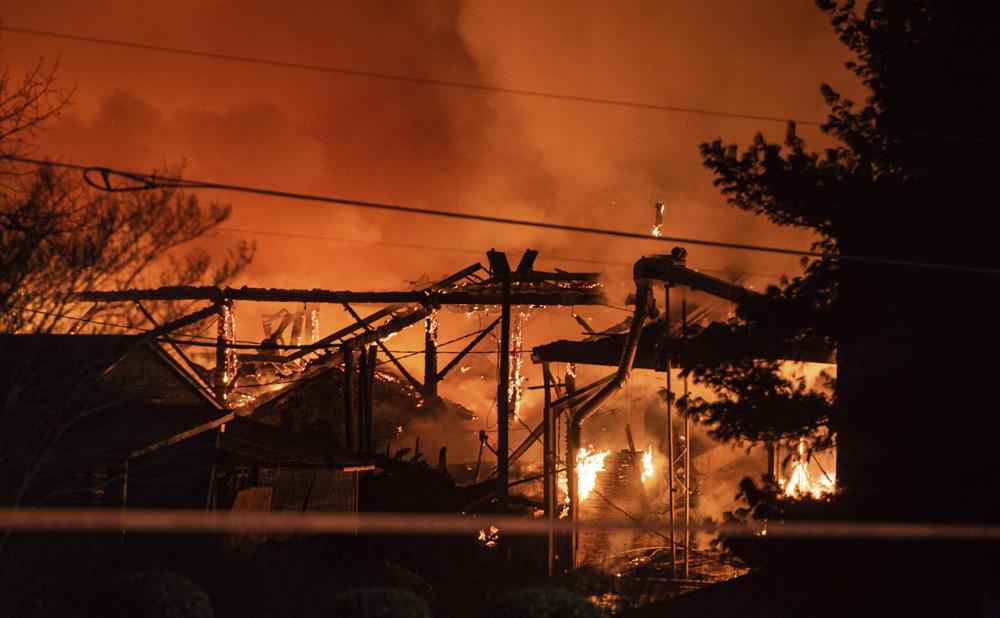An uncontrolled fire burning at a North Carolina fertilizer plant forced the evacuations of thousands of people as firefighters warned Tuesday that chemicals at the site could cause a large explosion.
Authorities drove through neighborhoods and knocked on doors asking residents to leave within a one-mile radius (1.6 km) of the Winston Weaver Company fertilizer plant on the northside of Winston-Salem, where the fire started Monday night. No injuries were reported.
Most of the campus of Wake Forest University is just outside the evacuation zone. The university urged students living in dormitories to stay indoors and keep windows closed.
Bright orange flames could be seen shooting into the sky along with thick plumes of smoke as lights from firetrucks and other first responder vehicles surrounded the fully engulfed building. The evacuation area included about 6,500 people in 2,500 homes, the Winston-Salem Fire Department said.
“We want to make sure that right now we’re evacuating everybody in this one-mile radius,” Winston-Salem Battalion Chief Patrick Grubbs told reporters early Tuesday. “There is still a potential for explosion.”
Firefighters had pulled back from the scene due to the danger of the uncontrolled fire, leaving behind an unmanned truck to pump water on part of the site, Grubbs said. Authorities also flew drones over periodically to assess the fire, and a state helicopter was going to take fire officials up for an aerial survey Tuesday morning.

At least 90 firefighters, along with emergency personnel from other agencies, fought the fire for about 90 minutes after it was discovered around 7 p.m. Monday, but they had to retreat because of the large volume of ammonium nitrate on the site, Winston-Salem Fire Chief Trey Mayo told reporters. The fire department said that firefighters could not flow enough water to be reasonably certain of keeping it cool enough to prevent a detonation.
Mayo told reporters Tuesday morning that an estimated 500 tons of the combustible chemical used in fertilizer were housed at the plant and another 100 tons were in a rail car adjacent to it. He said that is more ammonium nitrate than was present at a deadly blast at a 2013 Texas fertilizer plant blast that killed 15 people, most of them emergency personnel.
“So if that doesn’t convey the gravity of the situation and how serious folks need to take it, I don’t know how else to verbalize that,” he said of the comparison.

Mayo said that the chemical generally needs to be in a confined space or under pressure to explode, so the risk will depend on whether the material is stacked in piles deep enough to detonate. He said that as of 9 a.m., the fire had been relatively stable overnight but that the explosion potential will last for a total of about 36 hours, or into Wednesday morning.
Grubbs warned that there was going to be a lot of smoke and poor air quality in the city of about 250,000, and that controlling the fire could take some time. Matthew Smith, a hazardous material expert with a regional state task force, said the gases released by the blaze are considered more of an irritant than something that could seriously harm someone, unless they have an underlying lung condition.
Michelle Shepherd, who lives blocks from the plant, told the Winston-Salem Journal that after hearing and feeling explosions and seeing the flames Monday night, she didn’t wait for the evacuation order to leave her house and head to a shelter opened by local authorities.
“We felt big explosions. The entire house shook,” she told the newspaper. “And I looked out my front door and I could see the orange glow.”

Less than two miles (3 km) away, Wake Forest canceled classes for Tuesday and opened a campus building for students and staff who live off campus but had to relocate. The university said only one campus housing building was within the evacuation zone.
The Forsyth Correctional Center, a minimum security prison with the capacity for about 250 inmates, also is in the evacuation area.
Winston-Salem officials said a shelter has been set up at the Winston-Salem Fairgrounds. People who have evacuated should plan to be away from their homes for up to 48 hours.
The fertilizer plant was closed when the fire started and no employees were inside, local media outlets reported.
A company representative from the Winston Weaver Company didn’t immediately respond to an email seeking comment. The battalion chief told reporters that fire officials are in contact with the company, but didn’t have comments from them to share.
The company said on its website that it has operated the Winston-Salem plant since 1940.
(AP)













One Response
The company said on its website that it has operated the Winston-Salem plant since 1940.
Petro fertilizers were another lucrative product of Rockefeller and petroleum inventory. Well into the 1930s, traditional farming was about crop rotation and natural fertilization (by animal and plant refuse mineralization). During the war effort, there was a premium on grains and other common produce that could be brought quickly to market. Many farmers therefore decided to use chemical fertilizers rather than rotate crops which mineralizes more slowly (and retains topsoil).
After the war, the petroleum industry had a glut of diesel and other oil product inventory on its hands, and let loose a salesforce on traditional farms around the country, particularly the midwest. They were able to convince many to invest permanently in petroleum-based fertilizer farming, rather than revert back to ‘crop rotation’ mineralization. This caused an increase in the ‘dustbowl’ effect on the midwest (and other farming areas), as the lack of crop rotation weakened the topsoil, causing it to blow away in the wind – along with its rich mineral content that helps grow nutrient-dense, high-brix crops. Thus, was the chemical fertilizer industry expanded yet more – including the development and greater use of many additional harmful herbicides, pesticides, and non-organic and GMO-crops and seeds that have myriad adverse affects on the environment and on consumers.